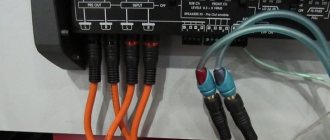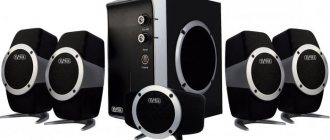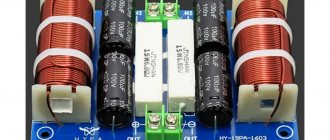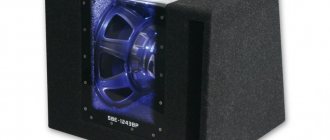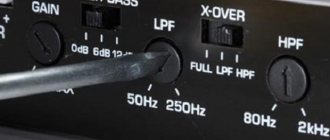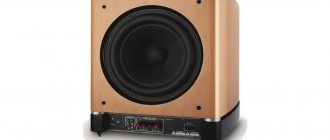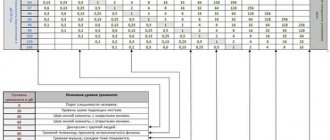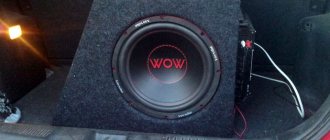HPF / LPF (HPF / LPF)
Hight pass filter (HPF), also known as a high-pass filter (HPF), filters out (cuts off) low frequencies, leaving high ones.
When setting up a subwoofer amplifier, set the control to about 20 Hz to cut out infrasound and not waste energy, since you won't hear it anyway. For mid-range speakers, the HPF is set around 80 Hz to remove the low frequency range for which the speaker is not designed and will not be able to play it. If you have separate channels or even a separate amplifier for tweeters (tweeters), the HPF is set in the region of 3000 - 5000 Hz, depending on the model, so as not to burn them.
All figures given are approximate, to obtain more accurate and safe values, study the characteristics of your speakers!
HPF and LPF (useful article - (AFC) Amplitude-frequency response)
Low pass filter (LPF), also known as a low pass filter (LPF), is the opposite of HPF and cuts off the upper frequencies, leaving the lower ones.
For subwoofers, it is set in the region of 50-80 Hz, depending on the type of design (ZYA, FI, etc.) in order to cut off frequencies for which the subwoofer is not intended. The same goes for midrange drivers, cut them around 1400-1600 Hz.
If possible, you can limit tweeters to 20,000 Hz, but this is not necessary.
Setting up "Sabsonic"
Afterwards you need to use a filter called “sabsonic”. In essence, this is a high-pass filter operating in the sub-bass region. Simply put, it cuts off infra-low frequencies from the signal and passes everything higher. Subsonic is not available on all amplifiers. But if your speaker operates in the acoustic design of FI or HF, then you need to choose an amplifier that has such a filter.
Why does he need a “sabsonic”? The fact is that the subwoofer speaker will also try to reproduce frequencies that lie outside the audible range, for example 20-25 Hz and below. At such frequencies, the diffuser stroke increases, which can lead to the coil leaving the gap and damaging it. Sabsonic cuts off all the “infra” and does not allow the speaker to exceed the stroke. In addition, the quality of reproduction of the desired bass range only improves, and the volume increases.
The “Sabsonic” should be tuned approximately 5 Hz below the tuning frequency of the bass reflex port. For example, if its tuning frequency is 35 Hz, then the subsonic should be tuned to 30 Hz. To do this, you need to turn on the switch and rotate the “twist” to the required numbers.
Gain\Level
Gain (sensitivity) is often confused with volume, but this is not entirely correct.
Gain is an adjustment of the amplifier's input sensitivity to match the radio. But let’s not get into the weeds and consider this setting from the point of view of what is useful for the user.
Sometimes the Volts (V) value indicated on the regulator can be misleading. The fact is that sensitivity is measured in Volts. The smaller V, the higher the sensitivity, the louder the speaker will play and vice versa.
To begin with, it will be useful to watch a clear video about how gain works on an amplifier:
Adjusting gain by ear (method 1)
Having a good sub link, do not use an equalizer and various bass enhancers, forget about bassboost on the amplifier - so before adjusting the gain, make sure that all this is turned off!
Set the control to minimum and play music that you usually listen to. Turn up the volume of the radio by 3/4 of the maximum; if you hear distortions in the sound of the subwoofer earlier, stop and turn down the volume a couple of notches. Go to the amplifier. Have an assistant slowly turn up the gain control until new distortion appears, and when you hear it, stop the rotation and turn it down by 10%.
Adjusting gain by ear (method 2)
If you don’t trust your hearing and are afraid not to hear changes during time, then use a more accurate method - using sinuses.
If you are tuning a subwoofer, then use 40 Hz, if your enclosure is tuned above 40 Hz or you have a closed box, then use 50 Hz, (). To set the gain for the midbass amp, use 315 Hz.
Sine or tone (in our case) is a tone signal of a certain frequency, changes in the sound of which you can easily hear
Set the gain to minimum, turn on your sine and turn up the volume of the radio. When changing the sound of the tone signal, stop and turn it down a couple of notches (set the maximum volume limit to this value if your radio has such a function). Go to the amplifier. Similarly to the first method, add gain. When the sound changes, stop and turn it down 10%.
Adjusting Gain Using a Multimeter or Oscilloscope
Adjusting the gain level using instruments is a smart and precise adjustment. At the same time, neither the speaker nor your ears are strained. This setup is shown in detail in the video on our YouTube channel:
Please note that when setting with a multimeter, you must be sure of the power declared by the amplifier manufacturer.
The most common woofer models
A car “sub” includes a low-frequency speaker with a rubber surround and a diffuser (polypropylene). The speaker head is placed in a housing, most often wooden. This entire structure is usually located in the trunk, since the structure is very bulky.
Today, the bulk of modern cars are equipped with standard audio systems, which also include a subwoofer.
In order to feel the full volume and depth of the sound of music tracks, the “sub” must be correctly acoustically designed. For this purpose, the speaker is placed in a special box. Today there are several design options. The most common are:
- Closed box.
- Bass reflex is the second most common option, which is quite easy to install and looks like a box with a port (slit or pipe). This structure significantly increases efficiency. The volume and sound quality are very good, but such a device requires a little more space.
- Quarter wave (labyrinth). This is also a fairly large device, but the sound quality will be much better than in previous versions.
Bassboost
Bassboost - increases the volume at a certain frequency, usually 40-45 Hz. When using a bass boost, the chance of burning the subwoofer increases sharply, since clipping occurs much earlier. In most cases, bassboost is not needed and if you are a beginner, then just accept the rule “Don’t touch bassboost!”
Experienced people can use it to increase the frequency response shelf in order to draw out dips in certain frequencies, but these are already deep settings and the effect does not always justify the risk.
Setting delays
The next step in setting up a subwoofer in a car is setting the delays. But this is only possible on a processor head unit or with an external processor. Some acoustic designs, such as FI, do not always have good impulse response, so the bass may be a little late. This is not always pleasant to hear.
For example, the front speakers played a note, and a split second later the sub played. To prevent this, the delays are adjusted, which allows the front speakers and subwoofer to play simultaneously.
Do you need a subwoofer?
Knowing this feature of a closed interior, it is logical to assume that there is no need for a separate subwoofer section in the car. This may be true, but let's compare car audio with home audio. In both cases, speakers of similar calibers are used - from 5 to 8 inches. 6.5 inches is the “golden mean” and a classic car speaker.
A home speaker is a single, complete unit, designed and manufactured to provide the best possible acoustic performance for the speakers. And most importantly - a durable body, free of vibrations. In a car, unfortunately, you can only dream about this most often. In most cases, the housings for the speakers are doors or some niches and spaces in the body elements. How to obtain normal reproduction of low frequencies under such conditions? Oh, don't be ridiculous.
This is how the speakers are installed in the Burmester 3D High End Sound System for 8000 Euros. To put it mildly, not the best acoustic design:
So it turns out that in most cases, acoustics are capable of more or less effectively “reaching” only up to 80-100 Hz, no matter what the manufacturers say. What a solid sound there is.
The situation can be corrected either by seriously strengthening the doors, turning it into a heavy “reinforced concrete” structure, or by manufacturing separate housings for the speakers. Well, or even go into something exotic:
In any case, attempts to create a low-playing speaker system come down to radical interference in the design of the car, and for this you need to be a real fanatic. Therefore, it turns out that a subwoofer is the most rational way to solve the car problem of low frequencies. Another thing is what exactly it should be and how to seamlessly merge it with the rest of the acoustics, so that it does not mumble in the trunk by itself, but is a full-fledged part of the sound system.
Making door enclosures is not so exotic, but also a very radical and expensive way to create the desired acoustic design for a speaker. In the photo - the work of Alexander Lysenko
Preparing equipment for adjustment
First, you need to pay attention to the process of installing equipment in a car. A suitable location is selected depending on whether the subwoofer is used - active or passive.
How to adjust an active subbuffer
The active version of the acoustics consists of two housings. One contains the amplifier, the other contains the main device. Installing such equipment is relatively simple. The main component is most often placed under the driver's seat, since this place is located close to the battery - you don't have to bother with wires. However, this will somewhat muffle the sound of the bass, and not everyone likes the vibration that occurs at some points.
An active subwoofer is easy to install, but requires careful configuration
You can also place the component in the back seat or on a special shelf. This will make it possible to better distribute sound throughout the cabin, but you will need to use several wires. Take two wires: narrow and wide. Connect them to the terminals of the acoustic equipment. The wide wire must be attached to the “+” terminal on the battery, and the narrow wire to the radio.
Most models of active equipment are equipped with a relatively weak bass amplifier. You can achieve normal sound only when listening at low volume. Its increase leads to the appearance of wheezing and other distortions. To avoid this, pay special attention to the settings.
How to set up passive acoustics
Passive subwoofers do not have a built-in amplifier, but it can be connected separately. Just make sure that the power of the main component is less than the power of the amplifier, otherwise it will overheat!
A passive subwoofer is popular with most audiophile drivers
How to properly adjust settings
It is important to take into account the driver's personal preferences. In general, the settings depend on what kind of music you listen to.
- Fans of rap, hip-hop and dubstep often enjoy "deep" bass that makes the whole body vibrate. To get it, you need to set the sound to a level of about 30–50 Hz. By the way, these genres are perhaps the only ones where such low sounds are used at all.
- If you prefer instrumental music, the minimum frequency level will be 40 Hz. Below is simply not necessary. Moreover, if you tune the bass too low, the double bass and bass guitar will lose overtones, which means the sound will become “artificial”, as if “electronic”.
- Fans of “club” music (“house”, “trance”) also do not require too low frequencies. Drum machines require a range of 40 to 100 Hz to reproduce.
It is important to coordinate the subwoofer with the midbass, otherwise the low frequencies will lose their emotionality. This is harmful for both live instruments and electronic music.
You will need to experiment with the BASS and LPF subwoofer switches
Why is it important to pair subwoofers and midbass correctly?
If the subwoofer is poorly connected to the midbass, the sound will be of poor quality and incomplete. This is especially noticeable at low frequencies, when instead of pure bass you get some kind of nonsense. Sometimes such disastrous scenarios are possible, when the sound from the subwoofer will play independently. In fact, this applies to all types of music, and not just, say, classical or rock music, where “live” musical instruments are played.
For example, in tracks that belong to the EDM genre, which is so popular among young people, the brightest bass is located precisely at the junction with midbass. If they are connected incorrectly, then the low-frequency loud bass will, at best, be less impressive, and at worst, it will be barely audible. Since the amplifier must be tuned to the same frequency, it is recommended to use an audio spectrum analyzer to obtain the most accurate data.
Setting up an amplifier for a Magnat subwoofer
In order to correctly and accurately adjust the ULF for a low-frequency speaker system, you need to follow some simple rules. First of all, you can't rush. Magnat is a complex electronic device, so it will take 3-4 hours to fine-tune it. In order for all acoustic systems to sound high quality, you need to use familiar musical fragments, where you can clearly feel the correct sound, which can be easily distinguished from a distorted one. In order to accurately catch the slightest negative nuances in the sound, the test should be carried out in the driver's seat with the doors and windows of the car interior closed. There is no need to limit yourself to playing only one fragment. The best thing to do would be to listen to music in different genres. There are no strict guidelines on the parameters of filters and phase, since much here depends on the individual characteristics of hearing. The main thing is to get the most accurate coordination between the bass and the front speakers. If all settings are made accurately, the low-frequency acoustic channel will work loudly, but harmoniously, without interrupting other speakers or falling out of the overall sound.
Setting up the amplifier for the subwoofer and front
In order for the bass frequencies not to “scatter”, but to sound in complete harmony with other channels, acoustic phase correction is performed. This parameter is best adjusted according to the driver’s subjective feelings. The “Acousticphase” regulator is located under the slot on the amplifier panel. You need to slowly turn the phase control until the bass frequencies reproduced by a separate speaker sound in the same plane. This is a subjective feeling, but if the phase is chosen incorrectly, it will seem that the bass and front are working separately, and there is no sense of harmony and integrity of the sound. Acousticians call this sound delamination. It is best to listen to a musical fragment and set the acoustic phase in the driver's seat, where the disturbances are most clearly noticeable.
Setting up an amplifier for a Fusion subwoofer
The Subsonic filter is responsible for the reproduction frequency of the low-frequency speaker system. Its installation is carried out by turning the corresponding regulator. Adjusting this unit allows you to remove the so-called spurious frequencies. They are located in an area of the sound range that is no longer audible to the human ear. These infra-low overtones can cause damage to the woofer cone. If the housing has a graduated scale in Hertz, then the optimal adjustment will be a frequency level five positions lower than the resonant frequency of the speaker system.
Sensitivity adjustment is also made for the slot and is marked “GAIN” or “LEVEL”. Some people incorrectly think of this as the volume level of the speaker system, but this is not the case. This tunable unit is a matching device between the car radio and the low-frequency system. In order to set it correctly, there is a simple technique:
- The controls on the radio and amplifiers are set to minimum.
- A piece of music is played.
- The volume level of the radio increases until distortion occurs.
- The volume is reduced to the threshold of clear sound.
- The amplifier volume is increased until distortion occurs.
- The volume is reduced until clear sound appears.
After completing these steps, you can assume that the radio and amplifier are completely coordinated. You can correctly configure the amplifier for the subwoofer only once, with the exception of cases where the speaker or car radio was replaced.
